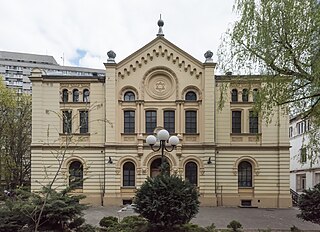
The Nożyk Synagogue is an Orthodox Jewish congregation and synagogue, located at 6 Twarda Street, in the Śródmieście district of Warsaw, in the Masovian Voivodeship of Poland.

The Zamość Synagogue, also the Zamość Old Synagogue or the Great Synagogue of Zamość, is a former Jewish congregation and synagogue, located in Zamość, in Lublin Voivodeship, Poland. Completed in 1618 in the Renaissance style, the synagogue is a UNESCO-protected World Heritage Site of Poland. Erected during the times of the Polish–Lithuanian Commonwealth, it functioned as a place of worship for Polish Jews until World War II, when the Nazis turned the interior into a carpenters' workshop. The structure was spared from destruction and in 1992 was listed as a World Heritage Site as part of the Old City of Zamość.

The Szydłów Synagogue is a former Orthodox Jewish congregation and synagogue, that is located at 3 Targowa Street, in Szydłów, in the Świętokrzyskie Voivodeship of Poland. The stone fortress synagogue with heavy buttresses on all sides was completed in 1564 in the Renaissance and Gothic Survival styles.

The High Synagogue was a former Orthodox Jewish congregation and synagogue, also known as the Tall Synagogue, located at Jozefa 38 Street, in the Kazimierz district of Kraków, in the Małopolskie Voivodeship of Poland.

The Old Synagogue was a former Orthodox Jewish congregation and fortress synagogue, located at 24 Szeroka Street, in the Kazimierz district of Kraków, in the Lesser Poland Voivodeship of Poland.

The Kupa Synagogue, also known as the Synagogue of the Poor, is a former Jewish congregation and synagogue, that is located at 8 Warszauera Street, in the historic Kazimierz district of Kraków, in the Lesser Poland Voivodeship of Poland. The 17th-century former synagogue is located in a neighborhood earmarked in 1495 by King John I Albert for the Jewish community, that was transferred from the budding Old Town.

The Kowea Itim le-Tora Synagogue was an Orthodox Jewish congregation and synagogue, located at 42 Józefa Street, in Kazimierz, Kraków, in the Lesser Poland Voivodeship of Poland. The congregation was known as the Society for Torah Study.

Tempel Synagogue was a Progressive Jewish synagogue, located at the Old Market Square 14 in Lviv, at the time part of the Austro-Hungarian Empire; and, since 1991, now in Ukraine. Lviv was one of the first Galician cities to have a modernized synagogue. The synagogue was destroyed by Nazi Germany in 1941, following Operation Barbarossa.

The Chachmei Lublin Yeshiva Synagogue is a Hasidic Jewish congregation, synagogue, and yeshiva, located at 85 Lubartowska Street, in Lublin, in the Lublin Voivodeship of Poland.

The Włodawa Synagogue is a former Orthodox Jewish congregation and synagogue complex, located at 5-7 Czerwonego Krzyża Street, in Włodawa, in the Lublin Voivodeship of Poland. The synagogue complex comprises the Włodawa Great Synagogue, the Small Synagogue or Beit midrash, and a Jewish administrative building, all now preserved as a Jewish museum.

The New Synagogue, also called Scheinbach’s Synagogue, is a former Orthodox Jewish congregation and synagogue, located at Juliusza Słowackiego 15, in Przemyśl, in the Podkarpackie Voivodeship of Poland. Designed by Stanisław Majerski and completed in 1918, the synagogue served as a house of prayer until World War II when it was desecrated by Nazis in 1939.

The Tykocin Synagogue is an historic former Jewish synagogue building, located in Tykocin, Podlaskie Voivodeship, Poland. The synagogue was completed in 1643, in the Mannerist-early Baroque style.

The Sejny Synagogue, also called the White Synagogue in Sejny, is a former Orthodox Jewish congregation and synagogue, located at 41 Piłsudskieo Street, in Sejny, in the Podlaskie Voivodeship of Poland. Designed in the Baroque Revival style and completed in 1885, the former synagogue was desecrated by Nazis during World War II and has been used as a Jewish museum and cultural center since 1987.

POLIN Museum of the History of Polish Jews is a museum on the site of the former Warsaw Ghetto. The Hebrew word Polin in the museum's English name means either "Poland" or "rest here" and relates to a legend about the arrival of the first Jews to Poland. Construction of the museum in designated land in Muranów, Warsaw's prewar Jewish quarter, began in 2009, following an international architectural competition won by Finnish architects Rainer Mahlamäki and Ilmari Lahdelma.

The White Stork Synagogue is a Conservative Jewish congregation and synagogue, located in Wrocław, in the Lower Silesian Voivodeship of Poland. Designed by Carl Ferdinand Langhans in the Neoclassical style and completed in 1829, the synagogue is located in the city's center, which was the northern edge of the former Jewish district.

The Nisko Synagogue was an Orthodox Jewish congregation and synagogue, located at 2 Polskiego Czerwonego Krzyża Street, in Nisko, in the Podkarpackie Voivodeship of Poland.

The Piaskower Synagogue is a former Orthodox Jewish congregation and synagogue, located at 3 Piękna Street, in the Piaski district of Białystok, in the Podlaskie Voivodeship of Poland.

The Kłodzko Synagogue, officially the Synagogue of Kłodzko, and formerly the Synagogue in Glatz, was a former Reform Jewish congregation and synagogue, located on the Grünestraße, in Glatz, Germany. This location is now Wojska Polskiego Street, in Kłodzko, in Kłodzko County in Lower Silesia, Poland.

The Maharshal's Synagogue, also known as the Great Lublin Synagogue, was a former Orthodox Jewish congregation and synagogue, that was located on the northern slope of castle hill at the now nonexistent 3 Jateczna Street, in Lublin, in the Lublin Voivodeship of Poland. The synagogue served as a house of prayer until World War II when it was destroyed by Nazis in 1942.



























